
- Sails & Canvas
- Hull & Structure
- Maintenance
- Sailing Stories
- Sailing Tips
- Boat Reviews
- Book Reviews
- Boats for Sale
- Post a Boat for Sale
- The Dogwatch
- Subscriptions
- Back Issues
- Article Collections
- Free for Sailors
Select Page

Hunter 33.5
Posted by Allen Penticoff | Boat Reviews , Monohull , Reviews
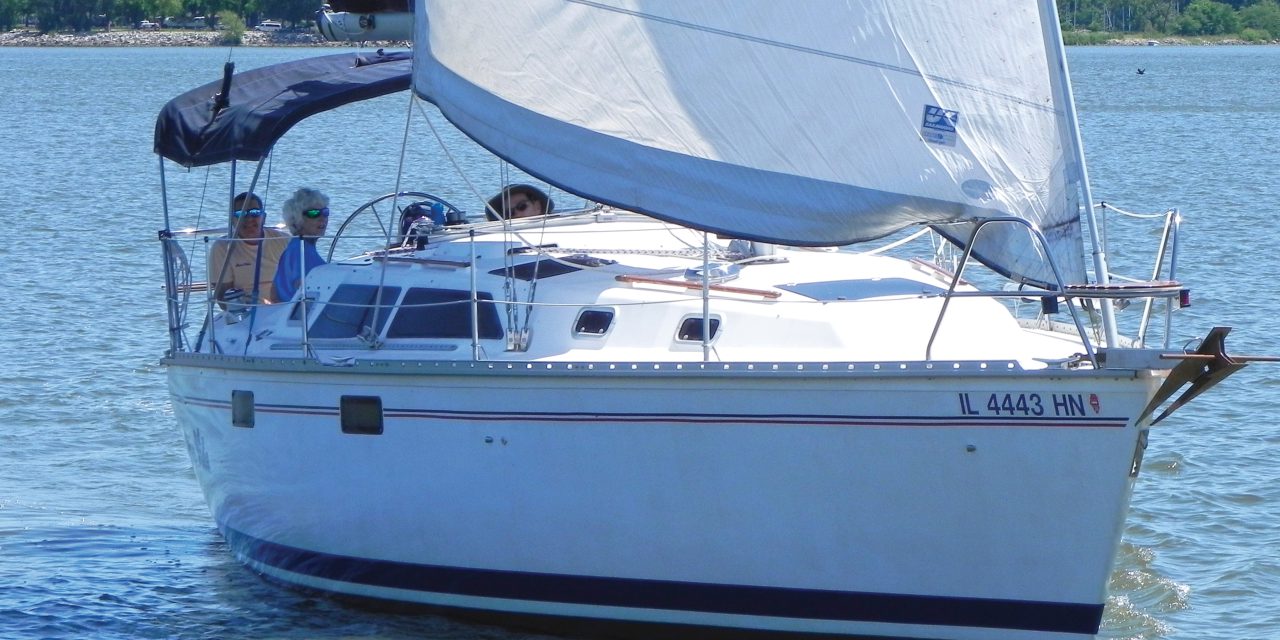
A well-planned economy cruiser
Rich and Carolyn Sutorius of St. Charles, Missouri, sailed a Seafarer 26, Manana , for more than 30 years. We reviewed the boat in the July/August 2019 issue . In 2021, with Rich now retired and Carolyn’s retirement approaching as well, she thought they should move up in boat size when they are able to spend more time aboard at their slip in Boulder Marina on Carlyle Lake in southwestern Illinois.
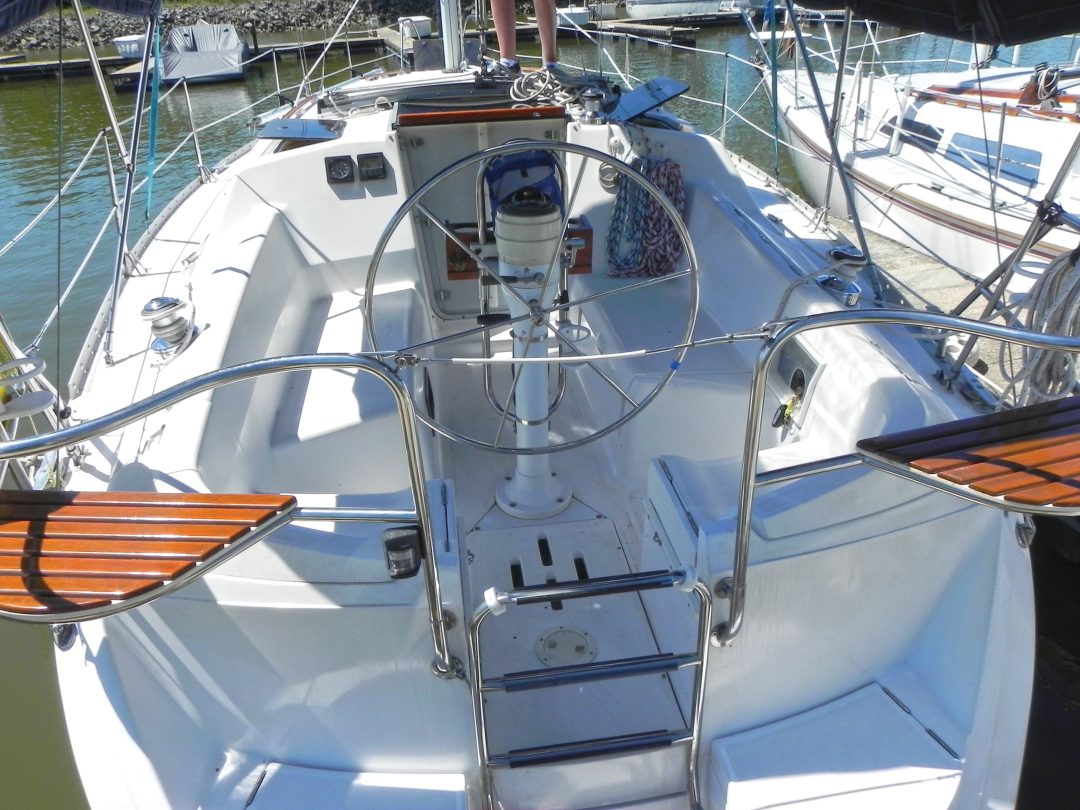
The cockpit is fairly roomy, but it’s a squeeze to get past the wheel, especially with the bimini up.
This request caught Rich by surprise, but he was not about to argue. They searched around the country for a Hunter in the 33-foot range. Most were iffy prospects and somewhat pricey, considering the difficulties in getting it to their landlocked lake. On my advice (we are friends) he asked several Hunter owners at his own marina if they’d like to sell, and as luck would have it, one said yes, even though it wasn’t technically for sale. Rich and Carolyn renamed the boat Pura Vida and launched her the following spring.
The Luhrs family built boats, both power and sail, for decades. Warren Luhrs, son of Luhrs company founder Henry, began the sailboat company in the early 1970s. He became a long-distance ocean racer with boats like Thursday’s Child , incorporating some of his ideas, like B&R rigging, in the production models. With his passing, the brand was bought by Marlow and the boats are marketed as Marlow-Hunters.

The seatback is part of the locker lid and it is somewhat large and clumsy to deal with, as it must be held up with one hand. A gas strut or spring to hold it open would be helpful.
The Hunter 33.5 was built from 1987 to 1994. Some know the 33.5 as the model 335, as there is a follow-on version designed by Rob Mazza called the Hunter 336 that has considerable updating starting in 1995. One can also find a very similar Hunter in the 34. One review, pre-336, says there were some 600 of the 33/33.5s built.
Several keel configurations were supposedly available: fin keel, bulb wing, elliptical wing, and Collins tandem keel. However, it is believed that nearly all of the 33.5s were built with the shoal draft (4 feet 6 inches) bulb wing keel as the review boat has.
Construction
Hunter Marine employed standard materials and construction methods in line with the boats’ intended price points as economy yachts. The hulls were hand-laid E-glass with polyester resin. They were solid, meaning no core material, with a skin coat behind the gelcoat of chopped strand mat sprayed with a chopper gun to help reduce print-through from the fabrics, such as 24-ounce woven roving, that followed. Decks were cored, some with 4-inch squares of plywood, others with sheets of end-grain balsa. Ballast was external.
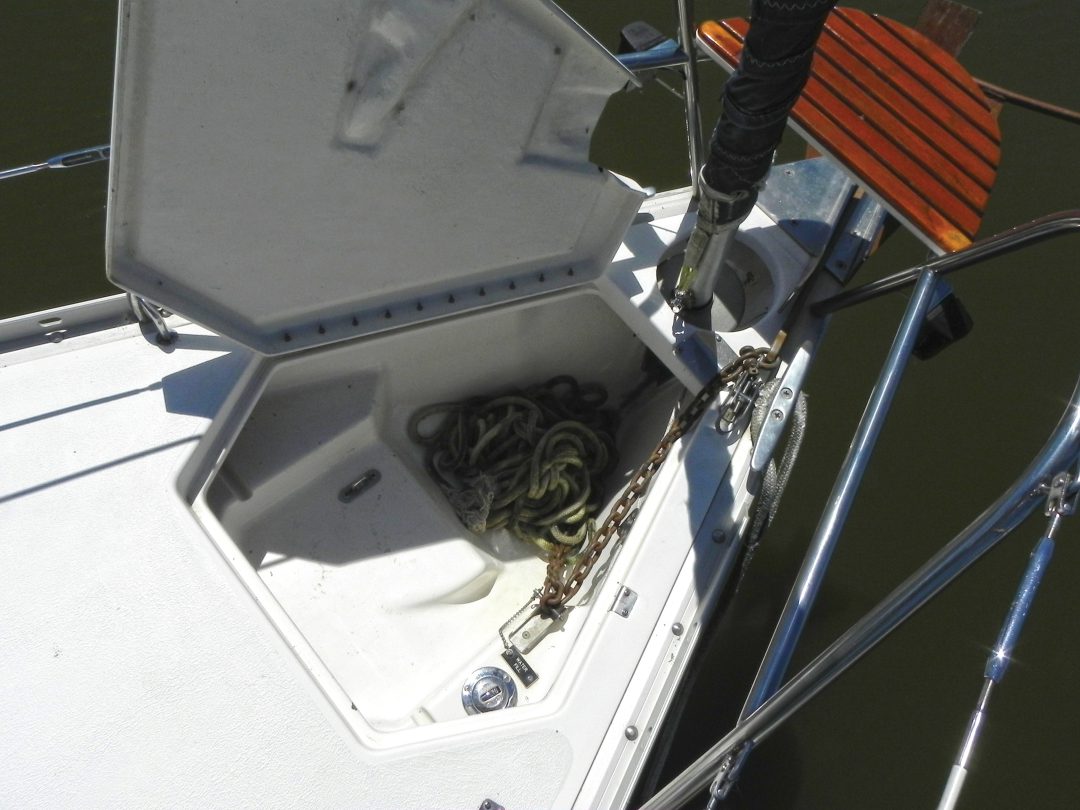
The drum for the headsail furler is recessed in the deck—an interesting detail. Ground tackle is also kept off the deck in a locker.
On my arrival at the marina, Pura Vida was tied stern-to at the dock, which enabled boarding via the transom opening as the humped helm seat had been removed and stowed. Getting around is very easy given the wide, clear sidedecks and the uncluttered cabintop that is ripe for sunbathing and lounging. Adequate handholds are available going forward to handle the anchor from a built-in locker.
The cabin trunk is relatively low, facilitating good forward visibility underway. Aluminum toerails edge the deck, with stainless steel pulpits at both ends and double lifelines between them.
There are two small lockers on the transom swim platform and two in the cockpit in each aft corner, which house the batteries. There is only one big cockpit locker, to starboard, and it’s not all that big or deep.
Engine gauges are to starboard of the wheel, but oddly and inconveniently, the engine cut-off knob is located at the top of the companionway steps. Aft of the wheel is
access to an emergency tiller connection and a large removable panel for service to the steering system. Between the mid-boom traveler just ahead of the companionway and the mast is a flat area clear of hardware that is perfect for lounging and sunbathing, as Carolyn demonstrated.
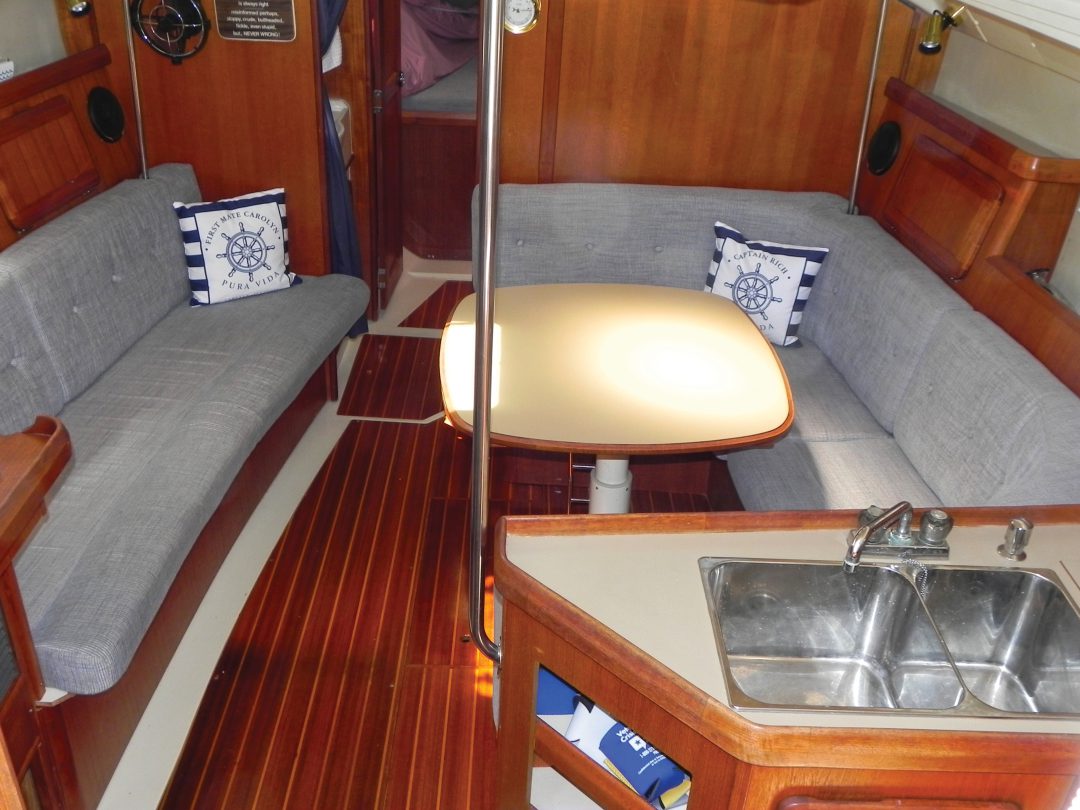
The saloon has a comfy dinette and table that lowers for a berth. Note the stainless steel tube that serves as a deck compression post as well as a much-appreciated handhold.
The rig is a ⁷/₈ fractional sloop, with double swept-back spreaders, double shrouds, and lowers from inboard-mounted chainplates. The backstay splits to free the helm of interference. Although sometimes reported as a B&R rig, it is not a B&R rig. Nonetheless, the swept spreaders do limit how far out the boom can be swung. Pura Vida sports a full-batten mainsail with lazy jacks and a roller-furled 110% headsail. Hunters in general lean toward tall main-driven sail plans with smaller, easier-to-trim jibs, and the 335 is no exception.
Accommodations
Going below, the first impression is a lot of wood and a lot of light. There are plenty of opening hatches that let in light, as well as windows on the cabin trunk sides. The first step is on top of a hinged cabinet/step that has a small handy tool bin under it. This makes a secure place to stand under sail as well. The hatch overhead is a dark acrylic plastic that slides into a sea hood. The way forward unfortunately is not endowed with overhead handholds. A light cream-colored padded vinyl covers non-wood surfaces that lend to the airiness of the cabin.
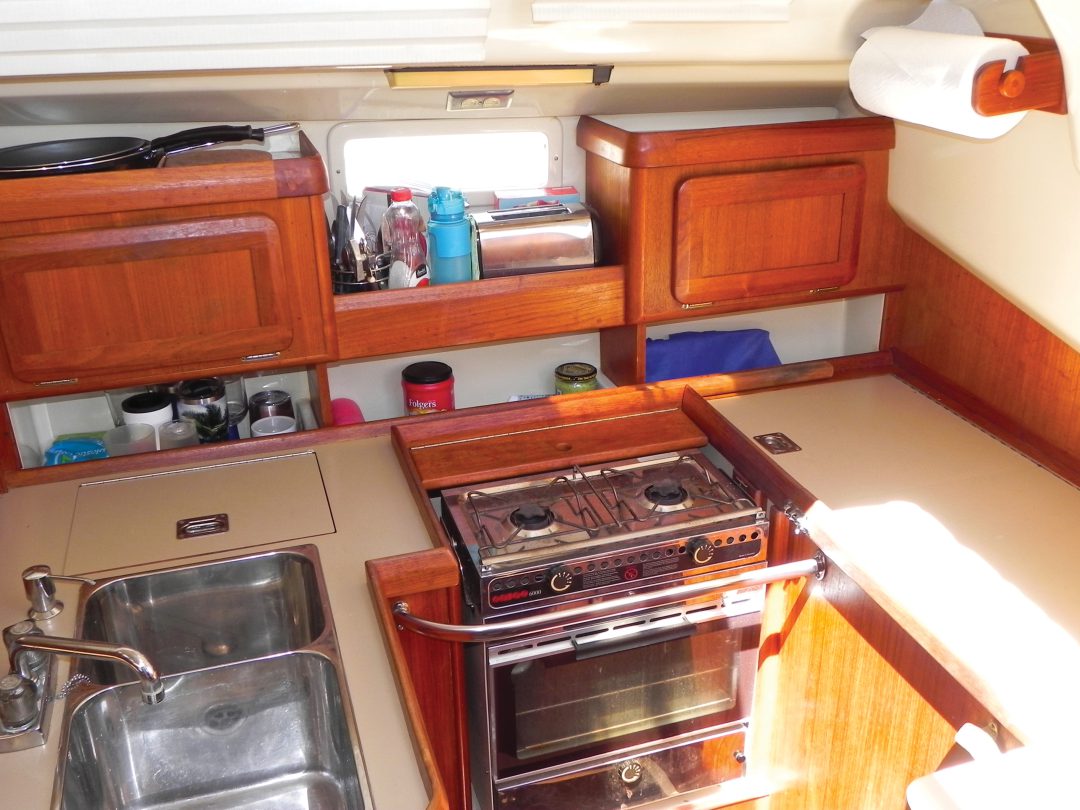
The gimbaled two-burner stove and double sink are nice features, as is the counter space for meal prep.
The forward cabin has a generous V-berth with cabinets and door—no need for an insert. I found it adequate for changing
clothes with the door closed. The aft “guest” cabin has a larger berth, but it suffers from being athwartship under the cockpit and if two are in bed, it makes the aft person in for the night. Couples may wish to split up and take separate cabins. The aft cabin is a great place to recline and read a book. Below the cushions is access to the engine-cooling through-hull, water strainers, fuel filter, prop shaft, and stuffing box. Other cabinets and engine access are found here as well.
The saloon features a wraparound dining table, which lowers to create a berth for two, while the port settee makes a berth once the back cushions are removed. Storage is abundant. The U-shaped galley takes up the aft star- board area, with plenty of workspace. The head/shower is to starboard with a vanity opposite. The head itself has a big lid over it, which Rich fitted with a hook after it fell on a male friend while sailing.
Pura Vida is equipped with a water-cooled marine air conditioner that has ducting to all three cabins.
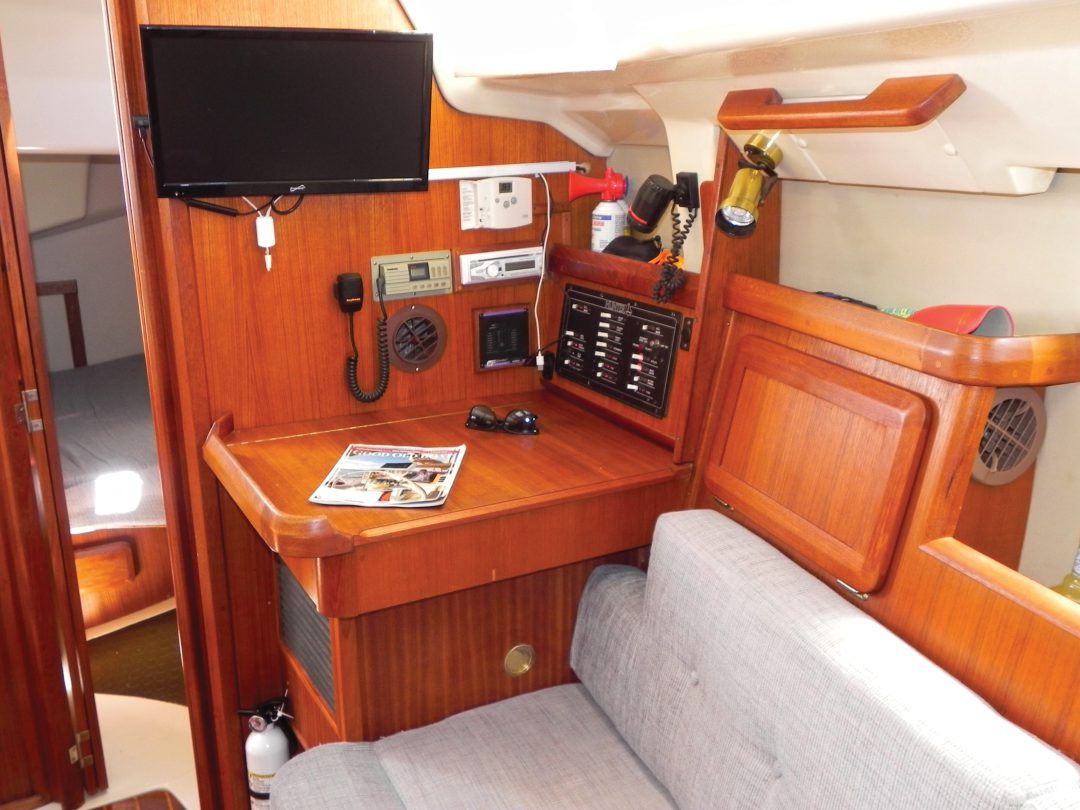
At the aft end of the port settee is the nav station, constructed in wood and with space for instruments and charts. You’ll probably want to stand at it rather than sit sideways.
The Hunter 33.5 handles quite well under sail and under power. With a shoal draft fin/bulb-winged keel and spade rudder, it turns quickly. We managed some tacks to windward quick enough that winching in the sheets was unnecessary. The main is a tad oversized and needs to be reefed early to prevent excessive weather helm. In average conditions there was a hint of weather helm and the helm feel was on the light side, but not quite fingertip control. The split backstays are completely out of the way while you are at the helm and there are many places to sit and steer. My favorite spot on most wheel-steered boats is to recline on the leeward seat snugged up against the coaming and steer with an up-and-down motion on the wheel. Some boats can even be steered with your feet, and this Hunter is one of them. Pura Vida has plush pulpit seats that are comfy for passengers, but they are a bit out of reach for a helmsperson.
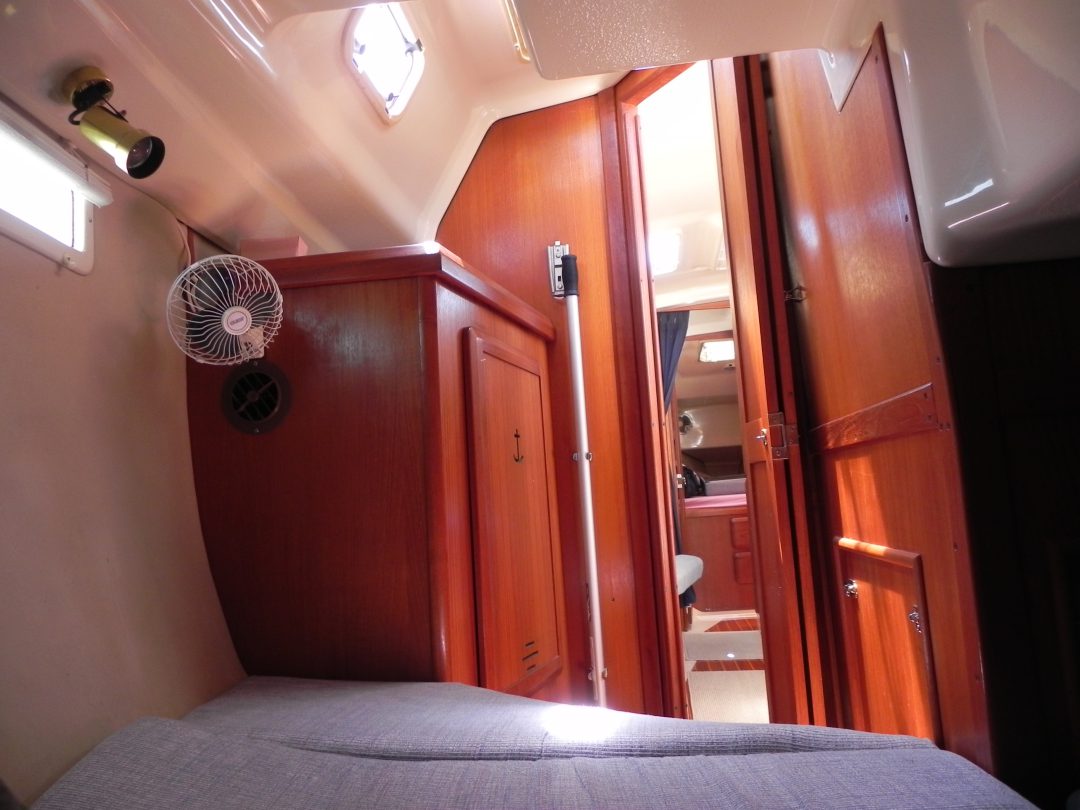
The aft berth, under the cockpit, is wide but not for the claustrophobic.
The cockpit seats are comfy, with adequate width and height. The tops of them are chamfered and blend into the sitting space. However, they are spaced just a bit too far apart to make for comfortable bracing while heeled. As for napability, I give these seats a 3.5 on the Penticoff Napability Index (PNI) of 1-5, with 1 being terrible and 5 being great. The 33.5’s seats are fine for reclining or curling up, but like many smaller yachts with a wheel, the cutout to get around the wheel takes away some of the napping comfort.
Having sailed downwind the length of the lake, we’d been planning to reef for the windward beat back to the marina as whitecaps were running the length of the lake now. However, we decided to take it even easier. We furled the main and then proceeded under jib alone. It was a pleasant sail. Handling was very neutral and light, with tracking spot on. Heel was minimal while pointing to 50 degrees and making 3.5 knots. It was so pleasant that as we came abeam the marina, Carolyn requested we continue for a while longer.
There are no surprises to sailing the Hunter 33.5 downwind or under power— standard stuff. However, Pura Vida’s folding prop has the usual lag when going from forward to reverse.
For PHRF racing, in fleets around the country most 33.5s rate 144–147 seconds per mile.
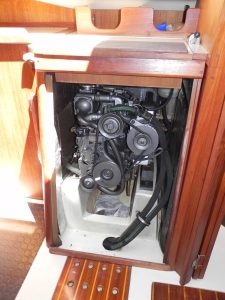
As with most boats, the Yanmar diesel is mounted under the cockpit and behind the companionway ladder. Opinions vary as to its accessibility.
There are many good old boats to choose from in this size range. Many of them are Hunters. Hunters have long been value-oriented production boats rather than top-of- the-line, spare-no-expense boats. Where some find fault with them, others find more boat for less money. I have not sailed a Hunter that I disliked or thought was inadequate for the sort of inshore sailing we usually do.
Listings for the Hunter 33.5 as of July 2022 ranged from $15,000 to $50,000.
There is a very large Hunter owners group online at shop.hunterowners.com for all things mechanical and technical.
Owners’ Comments
Points high and sails well on all points. I thought the hull and rigging were quite good for a relatively low-cost production boat. However, I was very disappointed at the quality of some of the components. The manual bilge pump was the cheapest one they could possibly buy and I had a catastrophic failure the first time I needed to use it. Also, the packing gland housing was made of a plastic material. Apparently, nearly all of the hatches had leaked since the boat was new. Sleeping accommodations were not great. Access to the rear of the engine was difficult.
—John Streatfeild, Guntersville, Alabama
Very small water intake regularly catches weeds and fish and plugs up at the hull. Walk-through and lockers in the swim step on stern are great—but this is still a narrower cockpit that fills up with four people.
—Andy and Sarah Reimer, Nanaimo, British Columbia
This boat is small enough to singlehand and big enough to take on moderate coastal seas. Downwind sailing is better on the B&R rig found on the 335 vs. the Selden rig seen in later models because the spreaders have almost no sweep. There’s a chart table, room for a 16,000 BTU marine A/C, a refrigeration box, and room on the forward bulkhead in the saloon to mount a modern, large flat-screen TV. There is not an option for an anchor roller, nor is there a way to install one on the 1990 335. The plumbing used Qest fittings, which are not readily available today. The standard Yanmar 2GM20F seems to be underpowered.
—Colby Whitfield, Kemah, Texas
Solidly built, set up for singlehanding, and comfortable belowdecks. Especially like the open transom design. I stow my 7.5-foot dink up against the stern. Passageways belowdecks are narrow/tight. Engine access is a bit awkward.
—Jim Mosher, Chesapeake Bay, Maryland
About The Author
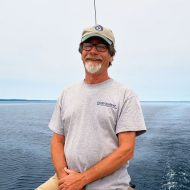
Allen Penticoff
Allen Penticoff, a Good Old Boat contributing editor, is a freelance writer, sailor, and longtime aviator. He has trailer-sailed on every Great Lake and on many inland waters and has had keelboat adventures on fresh and salt water. He owns an American 14.5, a MacGregor 26D, and a 1955 Beister 42-foot steel cutter that he stores as a someday project.
Related Posts
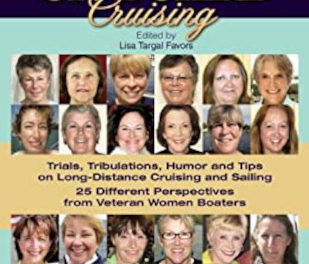
Women on Board Cruising: Book Review
April 1, 2011

Lessons Plans Ahoy!: Book Review
April 1, 2012
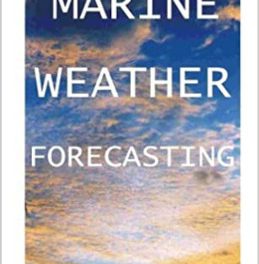
Marine Weather Forecasting: Book Review
September 1, 2000

Game of Sails: Book Review
May 15, 2020
Now on Newsstands
Join Our Mailing List
Get the best sailing news, boat project how-tos and more delivered to your inbox.
You have Successfully Subscribed!
Great choice! Your favorites are temporarily saved for this session. Sign in to save them permanently, access them on any device, and receive relevant alerts.
- Sailboat Guide
Hunter 33.5
Hunter 33.5 is a 33 ′ 4 ″ / 10.2 m monohull sailboat built by Hunter Marine between 1987 and 1994.

- 2 / 17 Gilford, NH, US 1988 Hunter 33.5 $22,000 USD View
- 3 / 17 South Amboy, NJ, US 1993 Hunter 33.5 $29,900 USD View
- 4 / 17 Gilford, NH, US 1988 Hunter 33.5 $22,000 USD View
- 5 / 17 South Amboy, NJ, US 1993 Hunter 33.5 $29,900 USD View
- 6 / 17 Gilford, NH, US 1988 Hunter 33.5 $22,000 USD View
- 7 / 17 South Amboy, NJ, US 1993 Hunter 33.5 $29,900 USD View
- 8 / 17 Gilford, NH, US 1988 Hunter 33.5 $22,000 USD View
- 9 / 17 Gilford, NH, US 1988 Hunter 33.5 $22,000 USD View
- 10 / 17 Gilford, NH, US 1988 Hunter 33.5 $22,000 USD View
- 11 / 17 South Amboy, NJ, US 1993 Hunter 33.5 $29,900 USD View
- 12 / 17 Gilford, NH, US 1988 Hunter 33.5 $22,000 USD View
- 13 / 17 Gilford, NH, US 1988 Hunter 33.5 $22,000 USD View
- 14 / 17 Gilford, NH, US 1988 Hunter 33.5 $22,000 USD View
- 15 / 17 Gilford, NH, US 1988 Hunter 33.5 $22,000 USD View
- 16 / 17 Gilford, NH, US 1988 Hunter 33.5 $22,000 USD View
- 17 / 17 Gilford, NH, US 1988 Hunter 33.5 $22,000 USD View
Rig and Sails
Auxilary power, accomodations, calculations.
The theoretical maximum speed that a displacement hull can move efficiently through the water is determined by it's waterline length and displacement. It may be unable to reach this speed if the boat is underpowered or heavily loaded, though it may exceed this speed given enough power. Read more.
Classic hull speed formula:
Hull Speed = 1.34 x √LWL
Max Speed/Length ratio = 8.26 ÷ Displacement/Length ratio .311 Hull Speed = Max Speed/Length ratio x √LWL
Sail Area / Displacement Ratio
A measure of the power of the sails relative to the weight of the boat. The higher the number, the higher the performance, but the harder the boat will be to handle. This ratio is a "non-dimensional" value that facilitates comparisons between boats of different types and sizes. Read more.
SA/D = SA ÷ (D ÷ 64) 2/3
- SA : Sail area in square feet, derived by adding the mainsail area to 100% of the foretriangle area (the lateral area above the deck between the mast and the forestay).
- D : Displacement in pounds.
Ballast / Displacement Ratio
A measure of the stability of a boat's hull that suggests how well a monohull will stand up to its sails. The ballast displacement ratio indicates how much of the weight of a boat is placed for maximum stability against capsizing and is an indicator of stiffness and resistance to capsize.
Ballast / Displacement * 100
Displacement / Length Ratio
A measure of the weight of the boat relative to it's length at the waterline. The higher a boat’s D/L ratio, the more easily it will carry a load and the more comfortable its motion will be. The lower a boat's ratio is, the less power it takes to drive the boat to its nominal hull speed or beyond. Read more.
D/L = (D ÷ 2240) ÷ (0.01 x LWL)³
- D: Displacement of the boat in pounds.
- LWL: Waterline length in feet
Comfort Ratio
This ratio assess how quickly and abruptly a boat’s hull reacts to waves in a significant seaway, these being the elements of a boat’s motion most likely to cause seasickness. Read more.
Comfort ratio = D ÷ (.65 x (.7 LWL + .3 LOA) x Beam 1.33 )
- D: Displacement of the boat in pounds
- LOA: Length overall in feet
- Beam: Width of boat at the widest point in feet
Capsize Screening Formula
This formula attempts to indicate whether a given boat might be too wide and light to readily right itself after being overturned in extreme conditions. Read more.
CSV = Beam ÷ ³√(D / 64)
A simlar version sold as the MOORINGS 335. At this time, this and other Hunter’s were available with several different keels including std.fin keel, ‘bulb wing’. ‘elliptical wing’ and ‘Collins tandem keel’.
Embed this page on your own website by copying and pasting this code.

- About Sailboat Guide
©2024 Sea Time Tech, LLC
This site is protected by reCAPTCHA and the Google Privacy Policy and Terms of Service apply.
The Hunter 33 is a 32.67ft masthead sloop designed by Cherubini and built in fiberglass by Hunter Marine (USA) since 1977.
The Hunter 33 is a moderate weight sailboat which is a reasonably good performer. It is stable / stiff and has a good righting capability if capsized. It is best suited as a coastal cruiser.
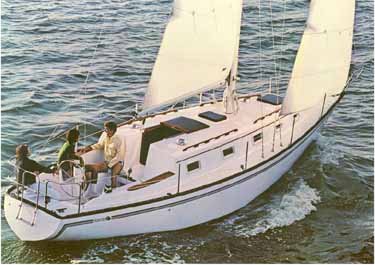
Hunter 33 for sale elsewhere on the web:

Main features
Login or register to personnalize this screen.
You will be able to pin external links of your choice.

See how Sailboatlab works in video

We help you build your own hydraulic steering system - Lecomble & Schmitt
Accommodations
Builder data, other photos.
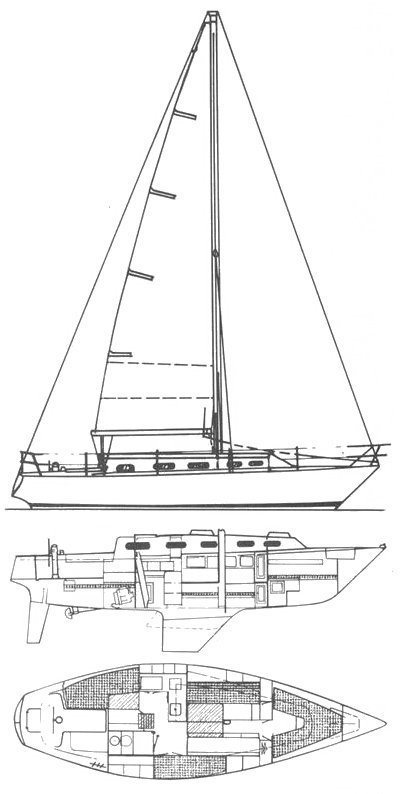
Modal Title
The content of your modal.
Personalize your sailboat data sheet
- New Sailboats
- Sailboats 21-30ft
- Sailboats 31-35ft
- Sailboats 36-40ft
- Sailboats Over 40ft
- Sailboats Under 21feet
- used_sailboats
- Apps and Computer Programs
- Communications
- Fishfinders
- Handheld Electronics
- Plotters MFDS Rradar
- Wind, Speed & Depth Instruments
- Anchoring Mooring
- Running Rigging
- Sails Canvas
- Standing Rigging
- Diesel Engines
- Off Grid Energy
- Cleaning Waxing
- DIY Projects
- Repair, Tools & Materials
- Spare Parts
- Tools & Gadgets
- Cabin Comfort
- Ventilation
- Footwear Apparel
- Foul Weather Gear
- Mailport & PS Advisor
- Inside Practical Sailor Blog
- Activate My Web Access
- Reset Password
- Pay My Bill
- Customer Service

- Free Newsletter
- Give a Gift

How to Sell Your Boat

Cal 2-46: A Venerable Lapworth Design Brought Up to Date

Rhumb Lines: Show Highlights from Annapolis

Open Transom Pros and Cons

Leaping Into Lithium

The Importance of Sea State in Weather Planning

Do-it-yourself Electrical System Survey and Inspection

Install a Standalone Sounder Without Drilling

When Should We Retire Dyneema Stays and Running Rigging?

Rethinking MOB Prevention

Top-notch Wind Indicators

The Everlasting Multihull Trampoline

How Dangerous is Your Shore Power?

DIY survey of boat solar and wind turbine systems

What’s Involved in Setting Up a Lithium Battery System?

The Scraper-only Approach to Bottom Paint Removal

Can You Recoat Dyneema?

Gonytia Hot Knife Proves its Mettle


Where Winches Dare to Go

The Day Sailor’s First-Aid Kit

Choosing and Securing Seat Cushions

Cockpit Drains on Race Boats

Rhumb Lines: Livin’ the Wharf Rat Life

Re-sealing the Seams on Waterproof Fabrics

Safer Sailing: Add Leg Loops to Your Harness

Waxing and Polishing Your Boat

Reducing Engine Room Noise

Tricks and Tips to Forming Do-it-yourself Rigging Terminals

Marine Toilet Maintenance Tips

Learning to Live with Plastic Boat Bits
- Sailboat Reviews
New Boat Review: Hunter 33
Redesigned family cruising boat sports new transom and deck plan..
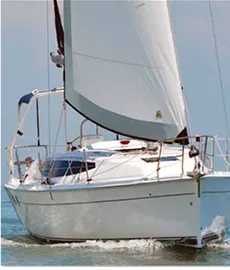
Photos courtesy of Hunter Marine
The new Hunter 33 had the odds stacked against it from the get-go.
The 33-foot family cruiser debuted in the fall of 2011, when the domestic sailboat market was stuck in a ditch, marketing budgets were slashed, and the U.S. boating industry was grasping at threads of good news. Four months later, Hunter Marine’s parent group Luhrs Marine filed for Chapter 11 bankruptcy protection.
Against all odds, however, the 33 is selling well. More than 60 have been ordered since the boat was introduced, and all but a few that have been built have been sold. It is one of Hunter’s best debuts since the 2008 downturn.
Looking ahead, the bankruptcy filing should be a boon for Hunter, as it will unshackle the sailboat side of the business from the struggling powerboat brands. Hunter, which converted to an employee-owned operation in 1996, expects to be out of the bankruptcy weeds by the end of July.
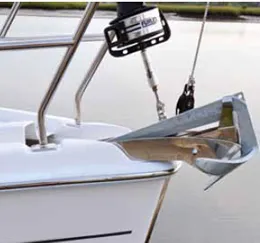
While new ownership appears in the offing for Hunter, co-founder Warren Luhrs will likely still have a stake. Luhrs—who’s 80-day sail from New York to San Francisco set a record in 1989—helped redefine Hunter in the 1990s. Under his leadership, design innovations by the late Swedish engineer Lars Bergstrom (the “B” in Hunter’s signature backstayless B&R rig) and faster hulls from designer Glen Henderson helped propel Hunter’s makeover through the last two decades.
“We have several very promising buyers interested, one in particular, but we can’t say anything right now,” said Greg Emerson, Hunter’s chief of public relations. The company has secured financing from Bank of America to help with the transition, allowing Hunter to continue full operations and provide warranty support without interruption.
Of the big three American boatbuilders (Catalina and Beneteau USA are the other two), Hunter reached the farthest outside the box as the traditional boat market sagged. The hybrid powerboat-sailboat Hunter Edge introduced in 2009 was a sharp departure from its usual fare. In 2010, it launched the Elco-powered electric hybrid e27. And last year, Hunter debuted the electric hybrid e36. The new Hunter 33, by comparison, is a case study in incremental changes. Below the waterline, it is virtually identical to the previous Hunter 33, of which 623 hulls were between 2005 and 2011.
Starting in the mid-1990s, Henderson began revamping the Hunter fleet, exploring ways to boost performance, make sailing easier, and create interior space for the creature comforts that Hunter owners expect. The new 33 bears Henderson’s signature changes—beam carried well aft to increase interior volume below, a concave hollow in the bow and shallow forefoot to reduce pitching motion, and a fractional rig to make maneuvering under sail easier. Trickling down from the ocean racing realm, hard chines are the new trend in the recreational market. Henderson located the new 33’s chine at the waterline, to aid in tracking when the boat is heeled.
One of three designers we spoke with in Practical Sailor’s 2005 designers conference, Henderson emphasized the importance of the rudder in providing lift. Like previous Henderson designs, the 33’s elliptical rudder is fairly large, and the keel is conservatively proportioned, allowing sufficient lead—the fore-and-aft distance between the center of effort and the center of lateral resistance—to make for a well-balanced sailer. (See PS, February 2009, “The Balancing Act.”) Hunter offers a 4-foot-6-inch shoal-draft version and 5-foot-6-inch deep draft of the new 33.
The boat’s excitement factor will depend a great deal on the sail plan. Henderson is a firm proponent of the fractional rig, with an easily tacked 110-percent furling jib. To up the fun-factor in light-air, a Code 0 asymmetrical sail will be a good investment.
For the mainsail, Hunter offers two options. Most buyers opt for the in-mast furling rig, an attractive choice for weekend cruisers who don’t want the hassles of setting and stowing a mainsail. Performance enthusiasts should opt for the standard rig. A full-battened, fat-head mainsail will significantly boost horsepower: The mast is shorter (by nearly 5 feet), lighter, and more aerodynamic than the furling mast.
Foregoing a furling main has trade-offs. Hunter’s overhead arch puts the aft end of the sail high above the cockpit, making setting and dousing a full-batten sail more of a chore, particularly if a full bimini is part of the picture. To simplify stowage, Hunter offers a self-stowing sailcover system with lazy jacks similar to those we looked at in our February 2008 article “Taming the Main.”
The clearest difference between the new 33 and the previous version is the new deck plan. The previous model had a walk-through transom that opened onto a stern boarding platform. The new model has a hinged transom cutout that folds down to create a swim platform that offers more area than the previous platform. As a result, the cockpit is larger, the main cabin can move aft, and the berth below the cockpit gains more space.
One big benefit of the larger cockpit, strictly from a cruising standpoint, is the bigger cockpit table. Featuring twin drop-down leaves hinged along the centerline, the 33’s table has a catch-all bin at its base—great for sunscreen, winch handles, and gloves—that doubles as a foot brace. There is plenty of room to move around the folded table, and older sailors will appreciate the extra handhold.
The previous model’s more secure—and unattractive, in our view—bathtub wrap-around coaming is gone. Instead, port and starboard lockers (starboard for propane tanks) are aft. The cockpit seats are technically too short for snoozing (4 feet, 9 inches by 1 foot, 6 inches), but seat cushions raise the seats up to the same level of the lazarettes, so you effectively have 5 feet, 7 inches to stretch out. Head clearance under the arch is 6 feet. A 4-inch bridgedeck keeps water from sloshing below. Lexan hatchboards stow in a dedicated storage bin in the port cockpit locker, ready as needed offshore.
Our test boat from Massey Marine in Palmetto, Fla., was equipped with the Mariner Package, which includes the overhead arch, an upgraded 29-horsepower Yanmar, Seldén in-mast mainsail furling with a rigid boom vang, a helm sheeting package for the jib, and the optional folding Lewmar steering wheel. It also had upgraded No. 30 Lewmar winches for reefing and furling lines; No. 16 winches are standard. A high-aspect canvas dodger and full-length cockpit canvas rounded out the package.
Sail control is easily managed from the cockpit. Halyards, reefing, and furling lines lead back to ganged Spinlock rope clutches at each side of the companionway. Molded line bins keep tails and toes from becoming ensnared. Mainsail control—both the traveler and mainsheet—can be reached from the helm, although the test boat’s full canvas awning made it hard to monitor the sheet tension and traveler car position, even with a cutout window over the helm. While mid-boom sheeting found on other boats doesn’t suffer this problem, Hunter sensibly prefers end-of-boom sheeting, which minimizes the loads on hardware and humans.
The 19-inch-high coaming offers security in a knock-down, but makes for a big step down to the sidedecks. While hardly expansive, the sidedecks allow easy passage fore and aft. Ample handholds and a low toerail offer security when moving forward. A reconfigured rig, with lower shrouds well inboard, also opens up the passage forward.
Six amply sized cleats (two at the bow, one on each stern quarter, and two amidship) handle docklines, but the stern cleats are vertically oriented, making them harder to access and poorly aligned with dock loads.
The self-draining anchor locker, single bow roller (two rollers are an option), and windlass gear meet the needs of a weekend sailor. This is a standard design on boats of this size, geared more toward aesthetics than midnight anchor drills on a pitching deck. (The more sensible hawse pipe is too much trouble for today’s sailors, it seems.) The anchor locker is relatively shallow, a poor match for someone who likes to pile on rode or carry two anchors. A locker divider is optional.
Most of the sailing hardware is Seldén gear, and this equipment has done very well in our previous tests. Seldén’s 200s Furlex, top rated in our August 2009 test, handles jib furling duties. Seldén’s in-mast furler and rigid vang help tame the mainsail, and Seldén’s top-rated bullet blocks (PS, June 2011) handle mainsheet loads. This is Hunter’s first big boat to feature Seldén’s mainsheet traveler.
The new 33 is the first Hunter model with a saildrive. The standard engine is the 21-horsepower Yanmar 3YM20, but our test boat featured the 29-horsepower 3YM30, which has a shaft output of 27 horsepower. The engine is mounted with the flywheel facing aft, so the gearbox and saildrive mounts and seals are easy to inspect and monitor. Access to the water pump, alternator, and drive belts is through a door in the aft cabin.
Yanmar recommends that this engine be hauled out, inspected, and serviced annually. Paint failure and corrosion on the aluminum lower unit are the chief concerns, so zincs need to be changed routinely, and the paint coating needs to be closely monitored. Copper-loaded bottom paints on the drive are a big no-no. If you live in a tropical climate and are trying to stretch your haulout intervals to three years, you may want to re-think the advantages of having a saildrive.
Saildrives simplify the builder’s job, and their only real advantages for the sailer are reduced underwater drag and some noise reduction. The standard prop is a bronze two-blade prop. Our test boat came with a folding two-blade prop. For long-term reliability and fewer maintenance headaches, we still prefer a conventional drive shaft system.
The boat’s standard systems are handled professionally and are adequate for daysailing, but most sailors will opt for a cruise-ready package, which includes some things we’d consider essential. There is also an iTech upgrade featuring additional HDMI and USB cabling and a cell-phone booster antenna for those who want to stay connected.
Bronze through-hulls have replaced the Marelon versions used on previous models. All seacocks are easily accessible and well labeled. Wiring and plumbing systems closely adhere to norms set by the American Boat and Yacht Council. The 25-gallon fuel tank is polyethylene. We prefer high-grade aluminum for fuel (PS, May 2007). The tank is well supported on all sides and small enough that the rotomolded tank’s biggest drawback—the difficulty of installing leak-free inspection ports—isn’t a major issue.
Hunter’s interior arrangements are among its strongest selling points. The computer-cut interior panels are assembled in modules outside the boat, significantly reducing labor cost. Joints, doors, and lockers that require skilled carpentry are pre-built and fitted in the workshop, where they can get the attention they deserve.
You won’t find finished edges on all plywood panels, but the warm cherry veneer, the creative use of space, and a few practical touches create an interior that is surprisingly roomy and comfortable for a boat of this size.
The extra space gained by pushing the cockpit aft allowed Hunter to angle the steps inboard, so one can walk down facing forward, with excellent handholds on either side of the companionway.
Headroom is 6 feet, 2 inches. White foam-backed material covers the overhead and sides. The material is held in place by grooved plastic track and can be removed and re-installed (with a special roller) to access deck hardware. This allows Hunter to through-bolt all hardware through a backing plate.
The main cabin and galley are well lit with big side windows, and two flush, frameless overhead hatches—one opening forward, the other opening aft—provide ventilation. The forward V-berth has its own hatch, and the aft cabin in the starboard quarter has a larger-than-queen-size bed, two ports and a fairly large hatch in the port settee. These hatches don’t get a whole lot of breeze in a still anchorage, but the space is much airier than that of previous models.
The galley is well-appointed, with a gimbaled, two-burner Force 10 stove and oven, and a single, deep sink. So long as you don’t need access to lockers or the ice-box (or optional freezer), there’s more than enough counter-space. Our test boat had a minimally insulated, front-opening fridge. These self-contained units work well for daysailing and dockside entertaining, but can be real energy hogs away from shore. A top-loading freezer/fridge with better insulation is an option.
The starboard head doubles as a shower, which has its own sump. The space’s snug fore-and-aft dimensions allow for a sleeping-length settee to starboard and the spacious aft cabin.
The dinette table has a slightly raised, fiddled catch-all for food, drinks, iPods, Barbie dolls, Legos, whatever. Beneath the vertical structure is a hand crank that raises and lowers the table, quickly converting it into a long 4-foot-4-inch-wide berth. This is a slick, one-person operation. Similarly, the center section of the starboard settee flips inboard to convert into a coffee table or small chart table.

Photo courtesy of Hunter Marine
Performance
We tested the boat in protected waters on the Bradenton River, Fla., in 10 to 12 knots northwest wind. A quarter-knot incoming tide was nearly aligned with the wind, and the following data, recorded by the GPS on our Velocitek ProStart, compensates for this current.
At 2,600 rpm, the upgraded 29-horsepower engine with a 13-inch, two-bladed folding Gori prop pushed the boat at 6.5 knots. At wide-open throttle, 3,400 rpm, the average speed was 7.3 knots and the wake was clean. The boat easily spun 180 degrees in little more than a single boat length, and it maneuvered easily under power in both forward and reverse. The engine was quiet with very little vibration at either speed, only slightly noisier at the higher rpm, registering 77 decibels in the center of the main saloon and in the cockpit with the companionway open. (Conversation is about 60-70 decibels.)
Even with shoal-draft and an in-mast furling mainsail that had no vertical battens, the test boat climbed to windward well; we would expect much better performance with the deep keel version and the standard mainsail.
Tacking angles were between 90 and 94 degrees. Close-reaching with the wind 45 degrees true and a relative windspeed of 14 knots, the boat made 4.9 knots over ground. Cracking off to 50 degrees true wind angle, the speed jumped to 6.4 knots. The fastest sustained speed was 6.5 knots at 70 degrees true, in 14 knots apparent wind.
Reaching between 130 and 160 degrees off the wind, the boat averaged between 5 and 5.5 knots. Apparent windspeed off the wind was between 6 and 8 knots, perfect conditions for an asymmetrical, although our test boat was not equipped with one. Throughout the test sail, the helm was exceptionally well balanced, even off the wind, and the boat accelerated nicely in puffs.
For a new, entry-level family cruiser, the Hunter 33 has a lot going for it. The $160,000 sailaway price is attractive; the five-year warranty on the hull is transferrable. A one-year stem-to-stern warranty covers major components, including things like refrigerators and windlasses.
Our tester was impressed by the excellent use of space in a boat of this size, both belowdecks and in the cockpit. In this respect, it is a big improvement over the previous Hunter 33.
Second was its performance on the water. Even with a battenless mainsail, this was a fun boat to sail. We’d encourage a stickler for performance to opt for the full-batten main.
Two concerns, in our view, are the standard iron keel and the sail drive, but you can’t expect a company like Hunter, for which pricing is a key sales point, to fight against market trends. A lead keel is an option for the Hunter 33, and is well worth the extra $9,800, in our view.
If you are having the boat hauled annually to ensure that the keel coating remains intact and the sail drive maintenance regimen is followed, you will avoid the problems that can crop up down the road. Certainly, around-the-can racing sailors will appreciate the reduced drag of the sail drive.
Hunter has had many years to learn what its customers like, and the variety of options in this boat will appeal to a wide range of sailors. We expect it to continue to sell well in this size range, and consider it a good fit for a coastal cruising family.
RELATED ARTICLES MORE FROM AUTHOR
Leave a reply cancel reply.
Log in to leave a comment
Latest Videos

Island Packet 370: What You Should Know | Boat Review

How To Make Starlink Better On Your Boat | Interview

Catalina 380: What You Should Know | Boat Review
- Privacy Policy
- Do Not Sell My Personal Information
- Online Account Activation
- Privacy Manager
- BOAT OF THE YEAR
- Newsletters
- Sailboat Reviews
- Boating Safety
- Sailing Totem
- Charter Resources
- Destinations
- Galley Recipes
- Living Aboard
- Sails and Rigging
- Maintenance
- Best Marine Electronics & Technology

- By Alvah Simon
- Updated: November 12, 2012
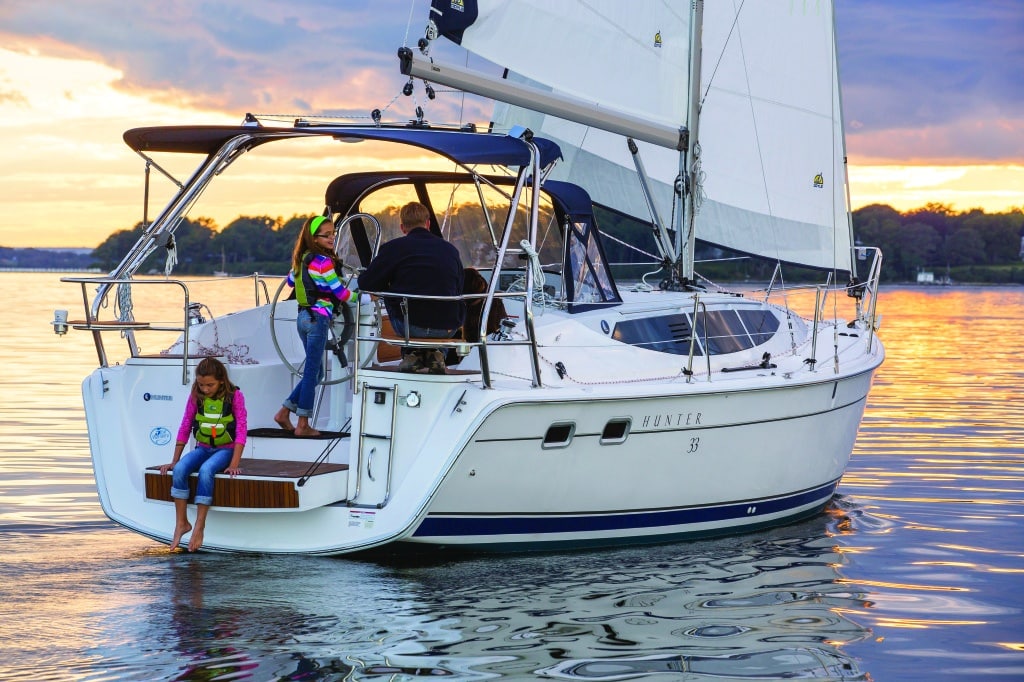
The boatbuilders at Marlow-Hunter , formerly known as Hunter Marine, may have been too successful, if that’s possible, with their prodigious production run of more than 600 Hunter 33 s. They found that the boat’s secondhand market was so vibrant that, in essence, they were competing against themselves for new-boat sales. They decided that by offering a new family cruiser of the same size but with significant innovations and upgrades, they might lure customers back into the new-boat market, and if they made the price very attractive, they might also entice trailer-sailors to make the leap up into a manageable keelboat.
The innovations and improvements found in the new and completely revamped Hunter 33 aren’t mere window dressing; they’re genuine leaps forward in speed, handling, comfort, and value. Always lurking is the risk of trying to squeeze too much into a small hull, such as larger cockpits, more spacious decks, increased interior volume, and a plethora of modern gadgetry. But Glen Henderson and the Hunter Design Group have found a superb balance in this package of upgrades.
The new hull still maintains Henderson’s signature hollow bow but now sports a trendy hard chine. By placing it beneath the waterline, Henderson sacrificed the cosmetic flourish of an elevated chine but found the sweet spot in terms of form stability and lateral resistance while under way.
Small but ultimately significant adjustments to the deck design add up to notable ergonomic efficiency. The cockpit pedestal has been moved back a few inches to create a larger cockpit area. A clever drop-down/walk-through transom adds to the usable space, and because this is a relatively high-sided vessel, it will be the preferred boarding point. The offset boarding ladder will come in handy for swimmers. The Lewmar wheel, when folded in, opens the access forward. But even in its full open position, it offers 10 inches of clearance between the wheel and the cockpit seats, giving the helmsman quick access to the sailing controls forward on the cabin top.
Two seats sculpted into the impregnable aft pulpit add to the already spacious outdoor social area. The steering pedestal is stout and holds an array of engine and navigational instruments, and it acts as the base for a sizable folding cockpit table.
It wouldn’t be a Hunter without the forward sloping arch with overhead, dual-ended mainsail sheeting. The headsail sheet winches are adequately sized and placed handy to the helm. Sheet wells built into the companionway bulkheads tame the abundance of sheets, halyards, and furling lines led aft to the cabin top.
There are ample stowage lockers, and the twin-bottle LPG locker is particularly well designed. I don’t like the three-washboard arrangement on a tapered companionway hatch, but this was the only fault I found in an otherwise excellent cockpit plan.
The deck has been redesigned with larger deadlights that allow more light below. Also, the lower shrouds have been moved inboard, creating an unencumbered flow forward. The new seahood covers the many lines leading aft, leaving a cleaner and, therefore, safer deck. The foredeck workspace is well thought out, with a small but adequate rode locker, a single roller, a recessed Lewmar windlass, and a snubbing cleat. The twin lifelines are coated but stand a minimal 23 inches high. I’d like to see this figure raised across the industry.
Though not touted as a performance cruiser, I found the 33 to be quick and responsive. Even with the in-mast furling option (not the fastest of sail plans), in only 5 to 7 knots of breeze, we maintained an honest 5.5 knots to windward and just under 5 with the wind on the beam. The 33 tacked effortlessly and tracked well. All in all, this is a slippery yet well-behaved hull.
Under power—the boat we tested had a 29-horsepower Yanmar diesel with saildrive—the vessel showed a good turn of speed, touching 6.5 knots at a cruising rpm and 7.5 when flat-out. (A 21-horsepower engine is also available.) It backed with precision and, due to the highly efficient balanced spade rudder, turned nearly in its own length. With the 33’s small size and snappy responsiveness, the boat should prove quite manageable in tight quarters.
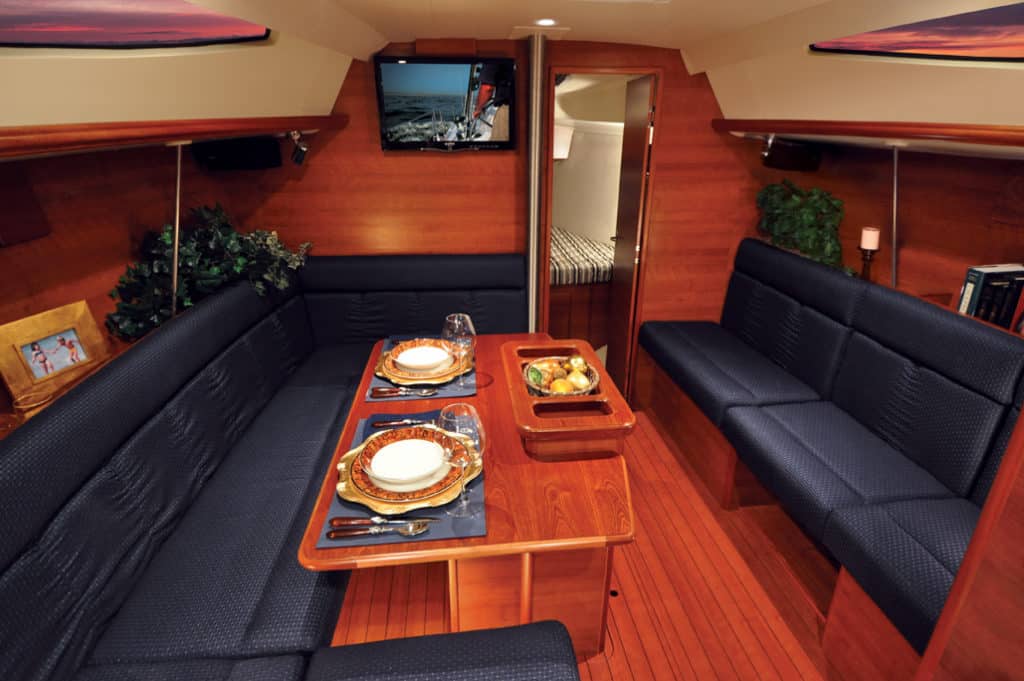
Where it really shines, however, is below. The interior is surprisingly spacious, bright, and well ventilated. Good handholds and the rounded teak companionway steps lead one safely below. A single full-size head and shower lie to starboard, across from a well-executed galley to port. The countertops are an attractive and practical white speckled Corian. A stainless-steel rail acts as both fiddle and handhold. The two-burner stove/oven is well fiddled but could use a little more angle when gimbaled. There’s a single but deep sink. The galley is large enough to work in conveniently but enclosed enough for safe use at sea.
The main saloon sports a very clever central table that’s built around a liquor/stowage cabinet. The table drops to create an additional berth. Across to starboard, a bench seat can be folded up to create a central cocktail table that doubles as the navigation station. Other amenities include a flat-screen TV and even an iPod docking station. Not mere gimmickry, this is a commitment to bringing the company’s styling, amenities, and electrical/mechanical systems up to the most modern of standards.
The owners cabin forward is bright, spacious, and offers good stowage spaces. The athwartship guest double lies in the stern to starboard.
The fit and finish are fine, and the overall cherry color and styling is pleasing to the eye. But more important, it must be noted again that this is only a 33-foot sailboat, and yet it contains two private cabins, a full-service galley, a spacious central saloon area, a full-size head and shower, and a navigation station—while still offering easy engine access and room to spare for generous stowage of gear.
The Hunter 33 shows no incongruities in its core concept. This is a contemporary-looking, modern-feeling coastal or near-offshore cruiser designed to take an entire family to sea in ease, style, and comfort. The good news is that it can do this at an amazingly attractive price. With that combination of looks, performance, and value, Marlow-Hunter may find itself faced again, perhaps in just a few years, with the same fortunate problem that its new 33 was designed to solve.
Two-time circumnavigator Alvah Simon is a Cruising World Boat of the Year judge for 2013.
View a full photo gallery for the Hunter 33 here . Check out more boat reviews here .
- More: 2011+ , 31 - 40 ft , Boat of the Year , Coastal Cruising , marlow-hunter , monohull , Sailboat Reviews , Sailboats
- More Sailboats

Balance 442 “Lasai” Set to Debut

Sailboat Review: Tartan 455

Meet the Bali 5.8

Celebrating a Classic

Kirsten Neuschäfer Receives CCA Blue Water Medal

2024 Regata del Sol al Sol Registration Closing Soon

US Sailing Honors Bob Johnstone

Bitter End Expands Watersports Program
- Digital Edition
- Customer Service
- Privacy Policy
- Email Newsletters
- Cruising World
- Sailing World
- Salt Water Sportsman
- Sport Fishing
- Wakeboarding
Hunter 33.5
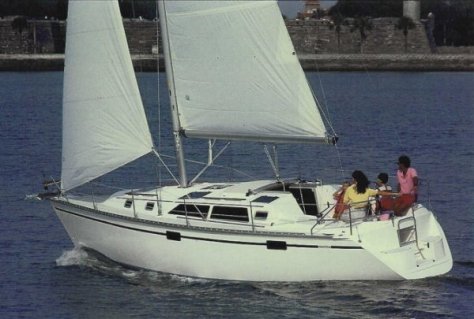
The Hunter 33.5 is an American sailboat that was designed for cruising and first built in 1987. The Hunter 33.5 design was developed into the Moorings 335 in 1988, as a charter version for Moorings Yacht Charter.
The Hunter 33.5 is a recreational keelboat, built predominantly of fiberglass, with wood trim. It has a fractional sloop B&R rig, a raked stem, a walk-through reverse transom, an internally-mounted spade-type rudder controlled by a wheel and a fixed fin keel. It displaces 11,000 lb (4,990 kg) and carries 4,500 lb (2,041 kg) of ballast. The boat has a draft of 4.50 ft (1.37 m) with the standard keel fitted. It was also available with a bulb wing keel, an elliptical wing keel or a Collins tandem keel.
The boat is fitted with a diesel engine. The fuel tank holds 42 U.S. gallons (160 L; 35 imp gal) and the fresh water tank has a capacity of 56 U.S. gallons (210 L; 47 imp gal).
The design has a PHRF racing average handicap of 147 with a high of 156 and low of 141. It has a hull speed of 6.96 kn (12.89 km/h).
Source: Wikipedia . Image Credit: boats.com
LOA: 33.33 ft LWL: 26.83 ft Beam: 10.92 ft Draft: 4.50 ft Displacement: 11000.00 lbs Ballast: 4500.00 lbs Hull type: Fin w/spade rudder Hull construction: FG Rigging type: B&R
Hunter 33.5 for sale in the last 12 months
Below you'll find the latest Hunter 33.5 listings for the last 12 months. We compare the listing price with boats listed in the past and the color coding indicates if the price is good (green = below the average listing price) or more on the expensive side (red = seller is asking more than the average listing price).
Hunter 33.5 listing prices over time
Listing details.
HUNTER 33.5 Detailed Review
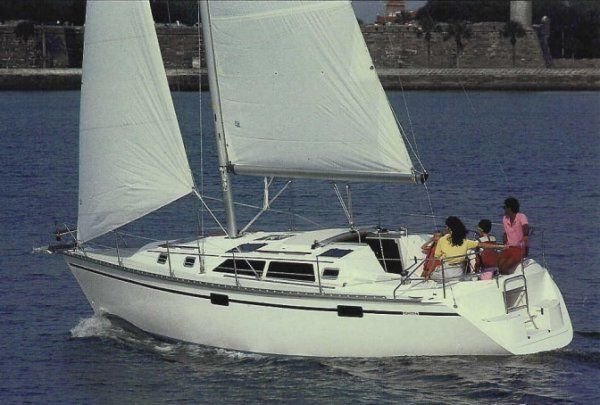
If you are a boat enthusiast looking to get more information on specs, built, make, etc. of different boats, then here is a complete review of HUNTER 33.5. Built by Hunter Marine (USA) and designed by undefined, the boat was first built in 1987. It has a hull type of Fin w/spade rudder and LOA is 10.16. Its sail area/displacement ratio 17.09. Its auxiliary power tank, manufactured by undefined, runs on Diesel.
HUNTER 33.5 has retained its value as a result of superior building, a solid reputation, and a devoted owner base. Read on to find out more about HUNTER 33.5 and decide if it is a fit for your boating needs.
Boat Information
Boat specifications, sail boat calculation, rig and sail specs, auxillary power tank, accomodations, contributions, who builds hunter 33.5.
HUNTER 33.5 is built by Hunter Marine (USA).
When was HUNTER 33.5 first built?
HUNTER 33.5 was first built in 1987.
How long is HUNTER 33.5?
HUNTER 33.5 is 8.18 m in length.
What is mast height on HUNTER 33.5?
HUNTER 33.5 has a mast height of 13.16 m.
Member Boats at HarborMoor

- Forums New posts Unanswered threads Register Top Posts Email
- What's new New posts New Posts (legacy) Latest activity New media
- Media New media New comments
- Boat Info Downloads Weekly Quiz Topic FAQ 10000boatnames.com
- Classifieds Sell Your Boat Used Gear for Sale
- Parts General Marine Parts Hunter Beneteau Catalina MacGregor Oday
- Help Terms of Use Monday Mail Subscribe Monday Mail Unsubscribe
Hunter 33.5 a bit tender
- Thread starter Vinny Johar
- Start date Feb 5, 2000
- Hunter Owner Forums
- Mid-Size Boats
Vinny Johar
I'm looking very seriously into purchasing a 1990 Hunter 33.5 as my transition from racing J/24's and J/30's into cruising. Some of the reviews I've read here, however, indicate that the Hunter 33.5 may be a bit tender as wind increases above 15 knots. The Displacement-Length Ratio (as I calculate it) is on the low end of Medium Displacement. I don't want a boat that's so stable it doesn't move in light breeze, but at the same time, since I will be single handing a lot, I would like to know I can eat a puff and not be on my ear. I've only sailed on one twice, but never with enough wind to know how it performs in the 20 knot range. Any input would be greatly appreciated.
Merrill Mant
33.5 Tender?? Our 92 33.5 is a supurb boat. We sail on Lake Champlain NY which is notorious for light winds as well as gusty blows between the mountains. It is true that we reef the main earlier than most other boats but this is more a function of the tall rig not a tender boat. We have a 150% genoa on our furler and find that once we start to furl it we loose performance substantially. (looking into a new 110% genoa)Above 25 knots of wind we usually use just the genoa and get 7.5+ knots of speed.... balance is more than acceptable. I regularly singlehand sail the boat with no difficulty at all. A lot of sailboat for your money and we do not regret our purchase in any way.
33.5 Tender Vinny, I own a '88 h33.5 and sail on Lake Pontchatrain in the New Orleans area. We usually sail in 10-18 knot winds. I usually start reefing the main at appx 18 knots. With 2 reef points on the main and the 110 roller furling jib, I can usually keep the boat trimmed and balanced pretty good. I can single hand the boat easily. The early models of the 33.5 were equipped with a 18 hp Yanmar and were under powered. I believe the '90 models have a 27 hp that should be ideal. Be sure to check the mast compression post encased in teak. The post is made of 2x4 wood. Mine rotted severely and required replacement last year. The wiring race beneath the mast became unsealed and allowed water to seep through the deck fitting onto the compression post resulting in deterioration of the post. Overall I think it is a lot of boat for the cost. I would buy another one if I had to do it again. Good Luck. David
Gary Wyngarden
Hunter 335 Stability Hey Vinny, I own a 1992 335 which I sail on Puget Sound in Seattle and points North. I sail principally with a 150 genoa. As previously commented, above 17 or 18 knots, she needs a reef in the main and a second if it get much above 20. I've found the 335 to be an excellent boat. We have retractable lazy jacks which really help with singlehanding. Good luck! Gary Wyngarden
Stephen Ostrander
I agree . . . with the previous posts. If you look at the mast height you will see that this is a very tall rig for her length, which makes her perform well, especially in light air. A lot of people race these boats sucessfully up here in the Great Lakes. You just have to get your reefing system working well so you can reef early and often. These boats reprersent an exceptional value and have tons of room below for their size. BTW, mine is a 1988 model with the 18hp Yanmar, and the only time its underpowered is motoring dead into a wind and chop. Otherwise, she cruises at hull speed, no problem.
Rob Rosenthal
She's not so tender Escape III is a '93 33.5. She does take nicely to light air with full up sails; but, when the winds kick on the Chesapeake at 20 + kts we usually get white caps and a bumpy ride. Reefing is very easy. Heck, just rolling up the 135 on the furler until the slot opens up is usually good enough through 22 kts. After that, I usually leave the jib rolled in and reef down. Once I was out in 26 kts and thought it best to take the second reef. I haven't been out in sustained winds much above 26kts. I do have an autopilot and that helps enourmously on solo sailing delights. /Rob
Another Information Resource Hopefully the previous posts give you the information you're looking for. If you're new to the site, another good area to look in is "The Boats", "Owner Reviews". Our boat is a Hunter 35, about 7/8ths fractional rig, and the same comments apply. In light winds the full main really helps to keep the boat moving and when it pipes up the first reef makes it a defacto mast-head rig. We sail a lot in lighter winds because fo the large main. In light winds I think an asymetrical would be a good addition to the sail inventory as most boats came standard with something around 110 to 130 jib. It's good to reef anyway so the main doesn't get blown out as easily.
Dutchman for single handed sailing I've got a '92 33.5 with 150 geno. I've sailed her in 30+ kts wind without much trouble off Cape Cod. Reefing the main at 20 kts recommended but she can handle 25 with full on (with quite a bit of leeway). In gusty conditions luffing the main a little will work well. Careful attention to trim will make big difference and speed will benefit from reducing sail in brisk conditiond. I sail with non-sailor wife & little kids and I've found that a combo of auto pilot and dutchman makes single handing a breeze Good luck
- This site uses cookies to help personalise content, tailor your experience and to keep you logged in if you register. By continuing to use this site, you are consenting to our use of cookies. Accept Learn more…

EUROINTECH LTD

Contact Information
Company name: EUROINTECH LTD
Company address: OFFICE 016 26 YUBILEINAYA STR 140011 LYUBERTSY , RUS
Website: http://eurointech.ru
Partner Highlights
We offer only that what we would prefer to operate! We make emphasis on excellent service, that results in increased customer base, customer’s satisfaction and loyalty. Today we have a lot of customers throughout Russia: many universities, research institutes and factories. Government companies as well as private business collaborate with us.
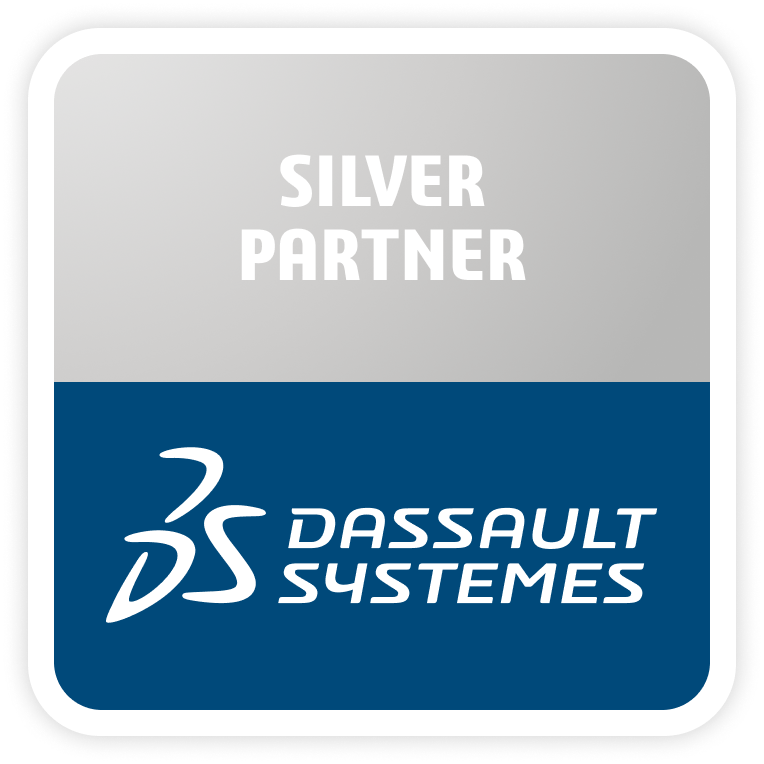
Reselling, Implementation, and Training
Explore partners solutions, explore customer and partner stories, more partners.

IMAGES
VIDEO
COMMENTS
A simlar version sold as the MOORINGS 335. At this time, this and other Hunter's were available with several different keels including std.fin keel, 'bulb wing'. 'elliptical wing' and 'Collins tandem keel'.
Design. The Hunter 33.5 is a recreational keelboat, built predominantly of fiberglass, with wood trim. It has a fractional sloop B&R rig, a raked stem, a walk-through reverse transom, an internally-mounted spade-type rudder controlled by a wheel and a fixed fin keel. It displaces 11,000 lb (4,990 kg) and carries 4,500 lb (2,041 kg) of ballast. [1]
The Hunter 33.5 was built from 1987 to 1994. Some know the 33.5 as the model 335, as there is a follow-on version designed by Rob Mazza called the Hunter 336 that has considerable updating starting in 1995. One can also find a very similar Hunter in the 34. One review, pre-336, says there were some 600 of the 33/33.5s built.
Perry Design Review: Hunter 33.5. Hunter Marine has combined contemporary styling, performance and very roomy interiors with very low prices to build a successful sailboat line. Their newest is the 33.5. The sailplan shows this to be a handsome design with, by today's standards, moderate freeboard, short ends and a clean wedge-shaped house.
Hunter 33.5 is a 33 ... Source: sailboatdata.com / CC BY. Embed Embed. View Demo. Embed this page on your own website by copying and pasting this code. For Sale View More . South Amboy, NJ, US 1993 Hunter 33.5 $29,900 USD. Gilford, NH, US ...
The Hunter 33 is a 32.67ft masthead sloop designed by Cherubini and built in fiberglass by Hunter Marine (USA) since 1977. ... The data on this page has been derived from different sources but a significant part is attributed to sailboatdata.com. We thank them for their encouragements and friendly collaboration.
Hunter offers a 4-foot-6-inch shoal-draft version and 5-foot-6-inch deep draft of the new 33. The boat's excitement factor will depend a great deal on the sail plan. Henderson is a firm proponent of the fractional rig, with an easily tacked 110-percent furling jib. To up the fun-factor in light-air, a Code 0 asymmetrical sail will be a good ...
Design. The Hunter 33 is a small recreational keelboat, built predominantly of fiberglass, with wood trim. It has a masthead sloop rig, a raked stem, a raised reverse transom, an internally-mounted spade-type rudder controlled by a wheel and a fixed fin keel. It displaces 10,600 lb (4,808 kg) and carries 4,100 lb (1,860 kg) of ballast.
Hunter 33. Fine performance and vast amenities abound in this versatile, upgraded 33-footer. Boat Review from our November 2012 issue. The boatbuilders at Marlow-Hunter, formerly known as Hunter Marine, may have been too successful, if that's possible, with their prodigious production run of more than 600 Hunter 33 s.
The interior finish adds to the richness with tongue-and-groove flooring and a high-gloss cherry veneer. The grain has been laid out on the bulkheads horizontally, which gives the salon a larger feel. The base price of the Hunter 33 with freight and commissioning is $120,000, and if you add the Mariner package, it goes up to $130,000.
LENGTH: Traditionally, LOA (length over all) equaled hull length. Today, many builders use LOA to include rail overhangs, bowsprits, etc. and LOD (length on deck) for hull length. That said, LOA may still mean LOD if the builder is being honest and using accepted industry standards developed by groups like the ABYC (American Boat and Yacht Council).
The Hunter 33.5 is an American sailboat that was designed for cruising and first built in 1987. The Hunter 33.5 design was developed into the Moorings 335 in 1988, as a charter version for Moorings Yacht Charter. ... More specs at sailboatdata. Hunter 33.5 for sale in the last 12 months.
If you are a boat enthusiast looking to get more information on specs, built, make, etc. of different boats, then here is a complete review of HUNTER 33.5. Built by Hunter Marine (USA) and designed by undefined, the boat was first built in 1987. It has a hull type of Fin w/spade rudder and LOA is 10.16. Its sail area/displacement ratio 17.09.
Feb 5, 2000. #1. I'm looking very seriously into purchasing a 1990 Hunter 33.5 as my transition from racing J/24's and J/30's into cruising. Some of the reviews I've read here, however, indicate that the Hunter 33.5 may be a bit tender as wind increases above 15 knots. The Displacement-Length Ratio (as I calculate it) is on the low end of ...
1989 Hunter 33.5. US$19,900. Eastern Yacht Sales, Inc. | Groton, Connecticut. Request Info. <. 1. >. * Price displayed is based on today's currency conversion rate of the listed sales price. Boats Group does not guarantee the accuracy of conversion rates and rates may differ than those provided by financial institutions at the time of transaction.
Warren Luhrs, founder of Hunter Marine began in the boat building business, first with his father and brother at Henry Luhrs Sea Skiffs and then Silverton Sea Skiffs. Both companies were quite successful. Being an avid sailor, Luhrs had the idea of applying production line efficiencies to the sailing industry. In 1973, the first Hunter sailboat was launched. This was the HUNTER 25, designed by ...
2007 Hunter 33. US$74,500. ↓ Price Drop. US $583/mo. Seacoast Yachts | Long Beach, California. Request Info. 22 listings. Find Hunter 33 boats for sale in your area & across the world on YachtWorld. Offering the best selection of Hunter boats to choose from.
Get directions to 3rd Pochtovoye Otdeleniye Street, 65 and view details like the building's postal code, description, photos, and reviews on each business in the building
Drive • 26 min. Drive from Lyubertsy to Moscow 23.5 km. RUB 170 - RUB 260. Quickest way to get there Cheapest option Distance between.
Drive • 27 min. Drive from Moscow to Lyubertsy 25.6 km. RUB 190 - RUB 280. Quickest way to get there Cheapest option Distance between.
LENGTH: Traditionally, LOA (length over all) equaled hull length. Today, many builders use LOA to include rail overhangs, bowsprits, etc. and LOD (length on deck) for hull length. That said, LOA may still mean LOD if the builder is being honest and using accepted industry standards developed by groups like the ABYC (American Boat and Yacht Council).
Eurointech Ltd. is a supplier of equipment, materials and EDA software for microelectronic industry in Russia. Foundation: 2007 year. Location: Lyubertsy, Moscow region.